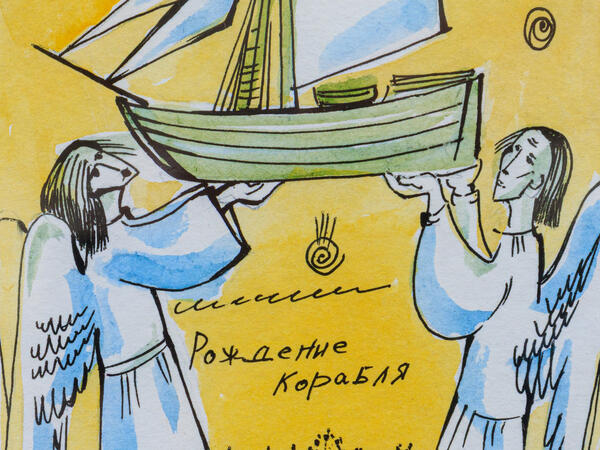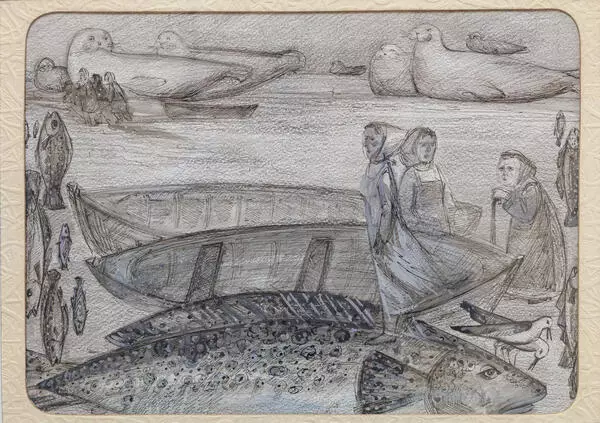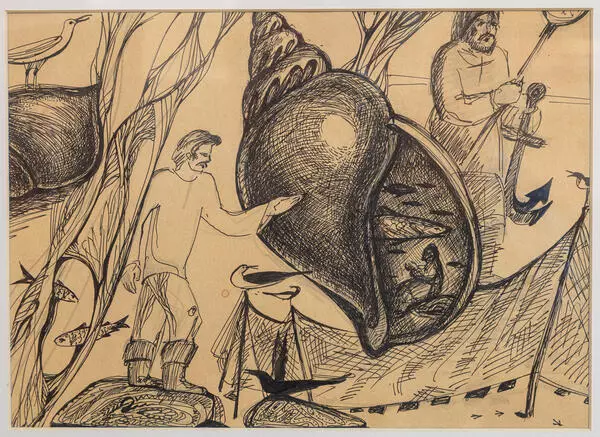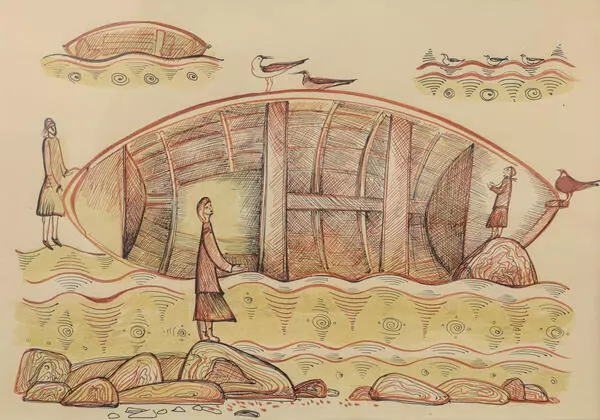The artist Ekaterina Sedacheva created the drawing ‘The Birth of a Ship’ using watercolors and black ink. This work is part of a series of works in which Sedacheva combined fabulous and surrealistic motives with details of the Pomor everyday life.
The background of the drawing is painted with watercolors in two colors: blue symbolizes the sea, yellow stands for the land and sky. In the center of the picture, two angels hold a wooden sailing ship in their raised hands. Both of them wear traditional Pomor shirts — long, with wide sleeves and belts. The angels stand on a large rounded boulder; two sea gulls are depicted at their feet. The Pomor believed that these birds personified the souls of those sailors who were ‘taken’ by the sea — they were often considered to be sailors' helpers. The title of the drawing ‘The Birth of a Ship’ is flanked by the figures of angels. In the center of the drawing, the outlines of a town can be seen in the distance.
The whole life of the Pomors was connected with the sea, so almost every family had its own boat, which was used for fishing, transportation or commercial trade, depending on the type of its owner’s occupation. All Pomor ships are usually called a “Koch”, but in fact, there were many varieties. Small maneuverable boats could be steered by one person or two people. These boats were made from spruce, and instead of nails, they were sometimes fastened with twisted juniper roots. This boat was sometimes called a “vichanka”.
A larger fishing vessel was called a “karbas”. They were usually managed by a team of at least four people.
For long-distance journeys and trade trips, spacious flat-bottomed boats were usually used. They could also serve as warships as cannons could be installed on board and the boat could carry up to 60 soldiers.
The Pomors had many superstitions and beliefs associated with ships. For instance, it was believed that one could send the wind in the right direction with the help of a special charmed stick, which the helmsman threw over his head. At the same time, it was believed that it was necessary to negotiate not with the wind itself, but with his wife praising her in a whisper and saying affectionate words, and simultaneously scolding the wife of the wind that blew in the opposite direction. And in case of a storm, one should pray to St. Nicholas whom the Pomors called St. Nicholas of the Sea. It was believed that this saint could help people without waiting for the permission of God, and therefore the sailors believed that protection from him would come faster than from other heavenly patrons.
The background of the drawing is painted with watercolors in two colors: blue symbolizes the sea, yellow stands for the land and sky. In the center of the picture, two angels hold a wooden sailing ship in their raised hands. Both of them wear traditional Pomor shirts — long, with wide sleeves and belts. The angels stand on a large rounded boulder; two sea gulls are depicted at their feet. The Pomor believed that these birds personified the souls of those sailors who were ‘taken’ by the sea — they were often considered to be sailors' helpers. The title of the drawing ‘The Birth of a Ship’ is flanked by the figures of angels. In the center of the drawing, the outlines of a town can be seen in the distance.
The whole life of the Pomors was connected with the sea, so almost every family had its own boat, which was used for fishing, transportation or commercial trade, depending on the type of its owner’s occupation. All Pomor ships are usually called a “Koch”, but in fact, there were many varieties. Small maneuverable boats could be steered by one person or two people. These boats were made from spruce, and instead of nails, they were sometimes fastened with twisted juniper roots. This boat was sometimes called a “vichanka”.
A larger fishing vessel was called a “karbas”. They were usually managed by a team of at least four people.
For long-distance journeys and trade trips, spacious flat-bottomed boats were usually used. They could also serve as warships as cannons could be installed on board and the boat could carry up to 60 soldiers.
The Pomors had many superstitions and beliefs associated with ships. For instance, it was believed that one could send the wind in the right direction with the help of a special charmed stick, which the helmsman threw over his head. At the same time, it was believed that it was necessary to negotiate not with the wind itself, but with his wife praising her in a whisper and saying affectionate words, and simultaneously scolding the wife of the wind that blew in the opposite direction. And in case of a storm, one should pray to St. Nicholas whom the Pomors called St. Nicholas of the Sea. It was believed that this saint could help people without waiting for the permission of God, and therefore the sailors believed that protection from him would come faster than from other heavenly patrons.










